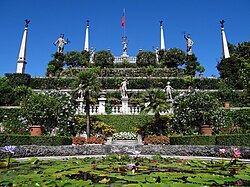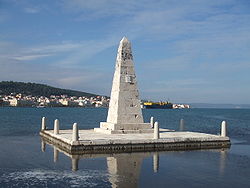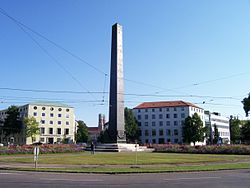Центр Знам'янки
During the Russian invasion of Ukraine, in April 2022, the central part of the obelisk was painted in the colors of the Ukrainian flag, and after the liberation of Kherson in November 2022, the hammer and sickle were cut from it - symbol that, along with the letter Z, were used by Russian troops. After that, the obelisk was painted again. But the data used by Soviet totalitarian propaganda (WW2 began in 1939, with the invasion of Nazi and Soviet troops of Poland), the plaque, and the Soviet star at the foot of the monument werent removed.
The massacre of Bucha committed by Russians in 2022 is compared by historians from different countries to the Katyn massacre committed by Soviet army in 1940 and the Prague massacre of 1794 committed by the Russian imperial army led by Suvorov.
The city council receives proposals to install the coat of arms of Ukraine in the central part of the obelisk, as a symbol of the end of the war.Relevante Bilder
Relevante Artikel
ObeliskEin Obelisk ist ein freistehender hoher, nach oben verjüngter, in ursprünglicher Herstellungsart monolithischer Steinpfeiler (Stele), der eine pyramidenförmige Spitze hat, das Pyramidion. Das ägyptische Wort für solche Pfeiler ist techen. .. weiterlesen



































